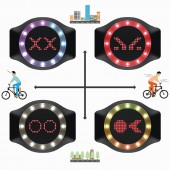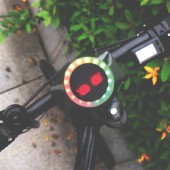DESIGN NAME:
uma-p
PRIMARY FUNCTION:
Smart Bike Light
INSPIRATION:
As smart products are being introduced into our daily lives, users are expected to build better connections with them. One of these products is the smart bike. Smart bikes can collect data which helps organizing biking in a more efficient way. However, users call for a more connective interaction to create empathy with the smart bike, instead of just scanning numbers on a screen. This requirement creates an opportunity for adaptive interaction that responds to the user’s habits and environment.
UNIQUE PROPERTIES / PROJECT DESCRIPTION:
Uma-p is a smart bike light that performs different facial expressions and eye movements to the biker based on its own machine personality. For example when the user is a fast biker and he is used to biking in a noisy environment, uma-p will gradually form its own personality of 'irritated';, which often performs red fury face to the user. However when there are other bikes nearby, the irritated light will try to keep calm and stay plain. It provides a brand new experience seeing bike as a pet.
OPERATION / FLOW / INTERACTION:
1.As the system starts, it will collect data about environmental variables and user habits, which influence the forming of machine personality.
2.The system will pick up a machine personality to be performed later by judging the historical average data of environmental variables and user habits.
3.Next it will seek for companions nearby with the companion sensor.
4.After that an action under the certain machine personality will be selected and performed according to historical data about user feedback and companion numbers.
5.Finally user feedback for this action will be collected and the next loop starts.
PROJECT DURATION AND LOCATION:
The project started in December 2015 in Hangzhou and finished in August 2016 in Guangzhou, and was exhibited in Excellence Graduation Design show during G20 in Hangzhou in September 2016.
FITS BEST INTO CATEGORY:
Interface, Interaction and User Experience Design
|
PRODUCTION / REALIZATION TECHNOLOGY:
The circuit prototype of uma-p had accelerometer, wifi and sound sensor as input, led pixles and rings as output. We designed a printed circuit board so it could be well implemented as a commerical product prototype.
The enclosure of UMA-P had metallic painted plastic as the main body and frosted acrylic to form a transparent light atmosphere. Also sillicon rings were made to fix the prototype on the bike handles.
SPECIFICATIONS / TECHNICAL PROPERTIES:
The product is 1250mm*840mm*500mm. The circuit prototype of uma-p had accelerometer, wifiI and sound sensor as input, led pixles and rings as output. We designed a printed circuit board so it could be well implemented as a commerical product prototype.
The enclosure of UMA-P had metallic painted plastic as the main body and frosted acrylic to form a transparent light atmosphere. Also sillicon rings were made to fix the prototype on the bike handles.
TAGS:
smart, bike, light, interaction, machine personality
RESEARCH ABSTRACT:
Due to the varying contexts in which social robots and smart products exist, it can be difficult to directly apply the rules of adaptive interaction for robots to smart products. Therefore, a new interaction framework named machine personality is introduced to fill this gap. It allows smart products to integrate new adaptive interactions, which are influenced by the environment, user habits and companions nearby. This framework is applied to a smart bike light for a connective biking experience and encouraging more biking.
CHALLENGE:
As more and more smart products are being introduced into our daily lives, users are expected to build better connections with them. One of these products is the smart bike. Smart bikes can collect data which helps organizing biking in a more efficient way. However, users call for a more connective interaction to create empathy with the smart bike, instead of just scanning numbers on a screen. This requirement creates an opportunity for adaptive interaction that responds to the user’s habits and environment.
After researching how a human gains emotional intelligence and forms his or her personality, a new interaction framework named machine personality is proposed. In this framework, the smart product will try to adjust its interaction mode to adapt to the user’s environment and habits. It collects data from the user and their environment to form its own personality gradually. What’s more, this product will not only react to the user but also to other smart products that have machine personality for creating a more connective interaction.
This framework will be applied to the interaction product UMA–P on a smart bike. It will collect data from user’s biking habits using an accelerometer and the noise of environment using a sound sensor. Based on this data it will form its own machine personality with three different actions, and perform one action with different LEDs as a facial expression each time. The user can give feedback on actions under a certain machine personality by touch sensor. UMA-P will try to perform those actions which users have previously given a high score. What’s more, it will search for other UMA-P’s in the surrounding area and respond to them with a different LED animation.
After going through a pilot test with users, this product is expected to give users a more interesting and connective biking experience that encourages them to use the smart bike more often.
ADDED DATE:
2016-11-30 13:28:22
TEAM MEMBERS (1) :
Jiachun Du, Ran Luo
IMAGE CREDITS:
Jiachun Du&Ran Luo, 2016.
PATENTS/COPYRIGHTS:
Patent in application
|









